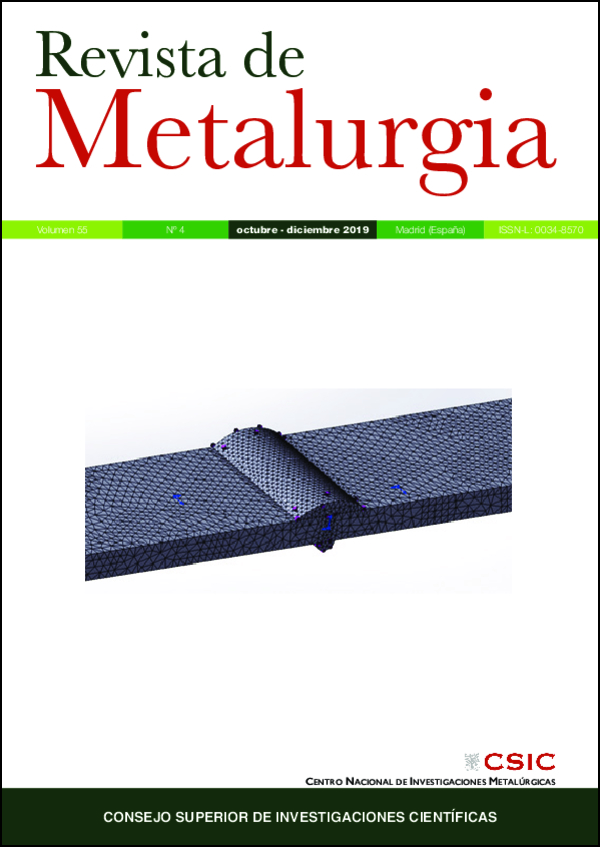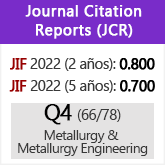La eliminación de metales tóxicos presentes en efluentes líquidos mediante resinas de cambio iónico. Parte XI: Cobalto(II)/H+/Lewatit TP260
DOI:
https://doi.org/10.3989/revmetalm.154Palabras clave:
Cobalto(II), Efluentes líquidos, Eliminación, Lewatit TP260, Nanotubos de carbono de pared múltipleResumen
Este trabajo investiga sobre la eliminación de cobalto(II) presente en medios acuosos mediante la resina de cambio iónico Lewatit TP260. El sistema se estudia bajo distintas condiciones experimentales: velocidad de agitación (300-1400 min-1), temperatura (20-60 ºC), pH del medio acuoso (1-5), dosificacion de la resina (0.07-0.5 g·L-1) y fuerza iónica de la disolución acuosa. El metal se carga en la resina mediante una reacción de intercambio catiónica en un proceso endotérmico y espontáneo. Esta reacción de intercambio se define por un proceso de difusión en la disolución acuosa y el modelo cinético de pseudo-primer orden (20 ºC) y el modelo cinético de pseudo-segundo orden (60 ºC), asimismo los resultados experimentales se ajustan bien a la isoterma de Langmuir. Los resultados experimentales del sistema se han comparado con los obtenidos con otras resinas de intercambio cationico y también con nanotubos de carbono de pared multiple oxidados y sin oxidar. Se estudia la selectividad del sistema Co(II)-Lewatit TP260 con respecto a la presencia de otros cationes (disoluciones binarias Co-metal) en el medio acuoso). El cobalto(II) cargado en la resina se puede fluir con disoluciones ácidas (HCl o H2SO4).
Descargas
Citas
Alguacil, F.J., Coedo, A.G., Dorado, T., Padilla, I. (2002). The removal of toxic metals from liquid effluents by ion exchange resins. Part I: chromium(VI)/sulphate/Dowex 1x8. Rev. Metal. 38 (4), 306-311. https://doi.org/10.3989/revmetalm.2002.v38.i4.412
Alguacil, F.J. (2002). The removal of toxic metals from liquid effluents by ion exchange resins. Part II: cadmium(II)/sulphate/Lewatit TP260. Rev. Metal. 38 (5), 348-352. https://doi.org/10.3989/revmetalm.2002.v38.i5.418
Alguacil, F.J. (2003). The removal of toxic metals from liquid effluents by ion exchange resins. Part III: copper(II)/sulphate/Amberlite 200. Rev. Metal. 39 (3), 205-209. https://doi.org/10.3989/revmetalm.2003.v39.i3.330
Alguacil, F.J., López, F.A., Rodriguez, O., Martinez-Ramirez, S., Garcia-Diaz, I. (2016). Sorption of indium (III) onto carbon nanotubes. Ecotox. Environ. Safe. 130, 81-86. https://doi.org/10.1016/j.ecoenv.2016.04.008 PMid:27085001
Alguacil, F.J., Garcia-Diaz, I., Lopez, F., Rodriguez, O. (2017). Removal of Cr(VI) and Au(III) from aqueous streams by the use of carbon nanoadsorption technology. Desalin. Water Treat. 63, 351-356. https://doi.org/10.5004/dwt.2017.0264
Alguacil, F.J. (2017a). The removal of toxic metals from liquid effluents by ion exchange resins. Part IV: chromium(III)/H+/Lewatit SP112. Rev. Metal. 53 (2), e093.
Alguacil, F.J. (2017b). The removal of toxic metals from liquid effluents by ion exchange resins. Part V: nickel(II)/H+/Dowex C400. Rev. Metal. 53 (4), e105.
Alguacil, F.J. (2018a). The removal of toxic metals from liquid effluents by ion exchange resins. Part VI: manganese(II)/H+/Lewatit K2621. Rev. Metal. 54 (2), e116.
Alguacil, F.J. (2018b). The removal of toxic metals from liquid effluents by ion exchange resins. Part VII: manganese(VII)/H+/Amberlite 958. Rev. Metal. 54 (3), e125.
Alguacil, F.J. (2018c). Adsorption of gold(I) and gold(III) using multiwalled carbon nanotubes. Appl. Sci. 8 (11), 2264. https://doi.org/10.3390/app8112264
Alguacil, F.J., Escudero, E. (2018). The removal of toxic metals from liquid effluents by ion exchange resins. Part VIII: arsenic(III)/OH-/Dowex 1x8. Rev. Metal. 54 (4), e132.
Alguacil, F.J. (2019a). The removal of toxic metals from liquid effluents by ion exchange resins. Part IX: lead(II)/H+/Amberlite IR-120. Rev. Metal. 55 (1), e138.
Alguacil, F.J. (2019b). The removal of toxic metals from liquid effluents by ion exchange resins. Part X: antimony(III)/H+/Ionac SR7. Rev. Metal. 55 (3), e152.
Anirudhan, T.S., Shainy, F., Deepa, J.R. (2019). Effective removal of Cobalt(II) ions from aqueous solutions and nuclear industry wastewater using sulfhydryl and carboxyl functionalised magnetite nanocellulose composite: batch adsorption studies. Chem. Ecol. 35 (3), 235-255. https://doi.org/10.1080/02757540.2018.1532999
Ashtari, P., Pourghahramani, P. (2018). Hydrometallurgical recycling of cobalt from zinc plants residue. J. Mater. Cycles Waste 20 (1), 155-166. https://doi.org/10.1007/s10163-016-0558-0
ATSDR (2004). Toxicological profile for cobalt. Agency for Toxic Substances and Disease Registry, Department of Health and Human Services, USA. https://www.atsdr.cdc.gov/toxprofiles/tp.asp?id=373&tid=64.
Bozecka, A., Surdek, A., Bozecki, P. (2018). Assessment of suitability of selected sorbents for removal of Co2+ ions from aqueous solutions. Przemysl Chemiczny 97, 1565-1568.
Cerpa, A., Alguacil, F.J., Lado, I., López, A., López, F.A. (2017). Removal of Ni(II) and Co(II) ions from acidic solutions by Lewatit TP-260 resin. Desalin. Water Treat. 70, 169-174. https://doi.org/10.5004/dwt.2017.20329
Daraei, H., Mittal, A. (2017). Investigation of adsorption performance of activated carbon prepared from waste tire for the removal of methylene blue dye from wastewater. Desalin. Water Treat. 90, 294-298. https://doi.org/10.5004/dwt.2017.21344
Devi, P.S.R., Kawadiya, S., Verma, R., Reddy, A.V.R. (2018). Determination of distribution ratios of Zr(IV), Co(II), Sb(V) and Nb(V) using polyaniline in acid solutions. J. Radioanal. Nucl. Ch. 317 (2), 881-889. https://doi.org/10.1007/s10967-018-5985-z
Farag, A.M., Sokker, H.H., Zayed, E.M., Eldien, F.A.N., Abd Alrahman, N.M. (2018). Removal of hazardous pollutants using bifunctional hydrogel obtained from modified, starch by grafting copolymerization. Int. J. Biol. Macromol. 120 (Part B), 2188-2199. https://doi.org/10.1016/j.ijbiomac.2018.06.171 PMid:30009903
Hayati, B., Maleki, A., Najafi, F., Gharibi, F., McKay, G., Gupta, V.K., Puttaiah, S.H., Marzban, N. (2018). Heavy metal adsorption using PAMAM/CNT nanocomposite from aqueous solution in batch and continuous fixed bed systems. Chem. Eng. J. 346, 258-270. https://doi.org/10.1016/j.cej.2018.03.172
Hemavathy, R.R.V., Kumar, P.S., Suganya, S., Swetha, V., Varjani, S.J. (2019). Modelling on the removal of toxic metal ions from aquatic system by different surface modified Cassia fistula seeds. Bioresource Technol. 281, 1-9. https://doi.org/10.1016/j.biortech.2019.02.070 PMid:30784996
Kara, I., Tunc, D., Sayin, F., Akar, S.T. (2018). Study on the performance of metakaolin based geopolymer for Mn(II) and Co(II) removal. Appl. Clay Sci. 161, 184-193. https://doi.org/10.1016/j.clay.2018.04.027
Kim, J.H., Gibb, H.J., Howe, P.D. (2006). Cobalt and inorganic cobalt compounds. World Health Organization. Geneva. Switzerland.
Leyssens, L., Vinck, B., Van Der Straeten, C., Wuyts, F., Maes, L. (2017). Cobalt toxicity in humans-A review of the potential sources and systemic health effects. Toxicology 387, 43-56. https://doi.org/10.1016/j.tox.2017.05.015 PMid:28572025
López Diaz-Pavon, A., Cerpa, A., Alguacil, F.J. (2014). Processing of indium(III) solutions via ion exchange with Lewatit K-2621 resin. Rev. Metal. 50 (2), e010. https://doi.org/10.3989/revmetalm.010
Ma, J., Qin, G., Zhang, Y., Sun, J., Wang, S., Jiang, L. (2018). Heavy metal removal from aqueous solutions by calcium silicate powder from waste coal fly-ash. J. Clean. Prod. 182, 776-782. https://doi.org/10.1016/j.jclepro.2018.02.115
Omelchuk, K., Chagnes, A. (2018). New cationic exchangers for the recovery of cobalt(II), nickel(II) and manganese(II) from acidic chloride solutions: Modelling of extraction curves. Hydrometallurgy 180, 96-103. https://doi.org/10.1016/j.hydromet.2018.07.003
Rodríguez, A., Sáez, P., Diez, E., Gómez, J.M., García, J., Bernabé, I. (2019). Highly efficient low-cost zeolite for cobalt removal from aqueous solutions: Characterization and performance. Environ. Prog. Sustain. Energy 38 (1), S352-S365. https://doi.org/10.1002/ep.13057
Rahmani, A., Karimi, G.R., Rahmani, A., Hosseini, M., Rahmani, A. (2017). Removal/separation of Co(II) ions from environmental sample solutions by MnFe2O4/bentonite nanocomposite as a magnetic biomaterial. Desalin. Water Treat. 89, 250-257. https://doi.org/10.5004/dwt.2017.21383
Song, Y., Tsuchida, Y., Matsumiya, M., Uchino, Y., Yanagi, I. (2018). Separation of tungsten and cobalt from WC-Co hard metal wastes using ion-exchange and solvent extraction with ionic liquid. Miner. Eng. 128, 224-229. https://doi.org/10.1016/j.mineng.2018.08.047
Vafaei, F., Torkaman, R., Moosavian, M.A., Zaheri, P. (2018). Optimization of extraction conditions using central composite design for the removal of Co(II) from chloride solution by supported liquid membrane. Chem. Eng. Res. Des. 133, 126-136. https://doi.org/10.1016/j.cherd.2018.03.010
Xavier, A.L., Adarme, O.F.H., Furtado, L.M., Ferreira, G.M.D., da Silva, L.H.M., Gil, L.F., Gurgel, L.V.A. (2018). Modeling adsorption of copper(II), cobalt(II) and nickel(II) metal ions from aqueous solution onto a new carboxylated sugarcane bagasse. Part II: Optimization of monocomponent fixed-bed column adsorption. J. Colloid Interf. Sci. 516, 431-445. https://doi.org/10.1016/j.jcis.2018.01.068 PMid:29408133
Yuan, G., Zhao, C., Tu, H., Li, M., Liu, J., Liao, J., Yang, Y., Yang, J., Liu, N. (2018). Removal of Co(II) from aqueous solution with Zr-based magnetic metal-organic framework composite. Inorg. Chim. Acta 483, 488-495. https://doi.org/10.1016/j.ica.2018.08.057
Zherebtsov, S.I., Malyshenko, N.V., Bryukhovetskaya, L.V., Lyrshchikov, S.Y., Ismagilov, Z.R. (2018). Sorption of Cobalt Cations by Humic Acids. Coke Chem. 61 (7), 266-269. https://doi.org/10.3103/S1068364X18070086
Publicado
Cómo citar
Número
Sección
Licencia
Derechos de autor 2019 Consejo Superior de Investigaciones Científicas (CSIC)

Esta obra está bajo una licencia internacional Creative Commons Atribución 4.0.
© CSIC. Los originales publicados en las ediciones impresa y electrónica de esta Revista son propiedad del Consejo Superior de Investigaciones Científicas, siendo necesario citar la procedencia en cualquier reproducción parcial o total.Salvo indicación contraria, todos los contenidos de la edición electrónica se distribuyen bajo una licencia de uso y distribución “Creative Commons Reconocimiento 4.0 Internacional ” (CC BY 4.0). Puede consultar desde aquí la versión informativa y el texto legal de la licencia. Esta circunstancia ha de hacerse constar expresamente de esta forma cuando sea necesario.
No se autoriza el depósito en repositorios, páginas web personales o similares de cualquier otra versión distinta a la publicada por el editor.


















